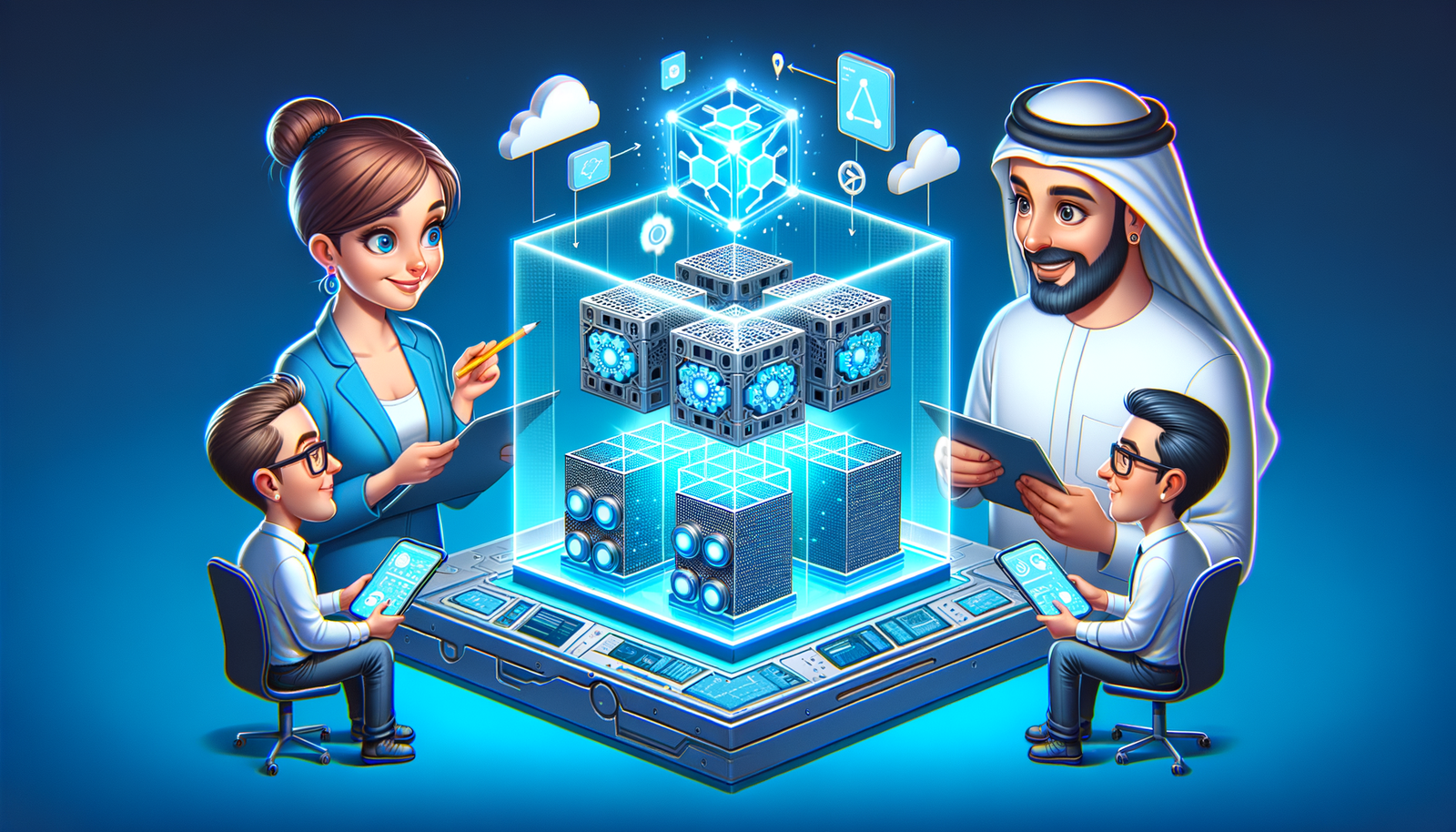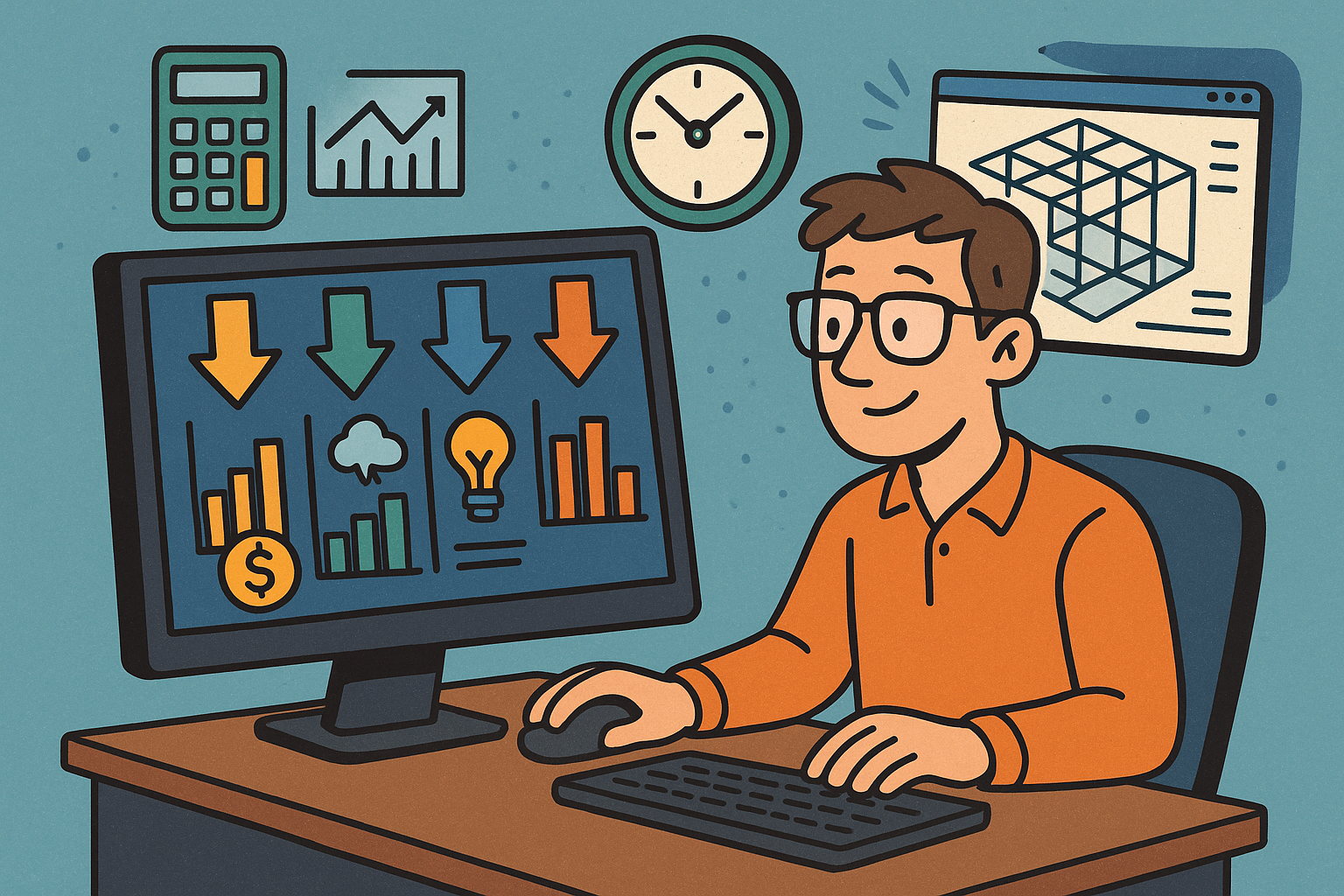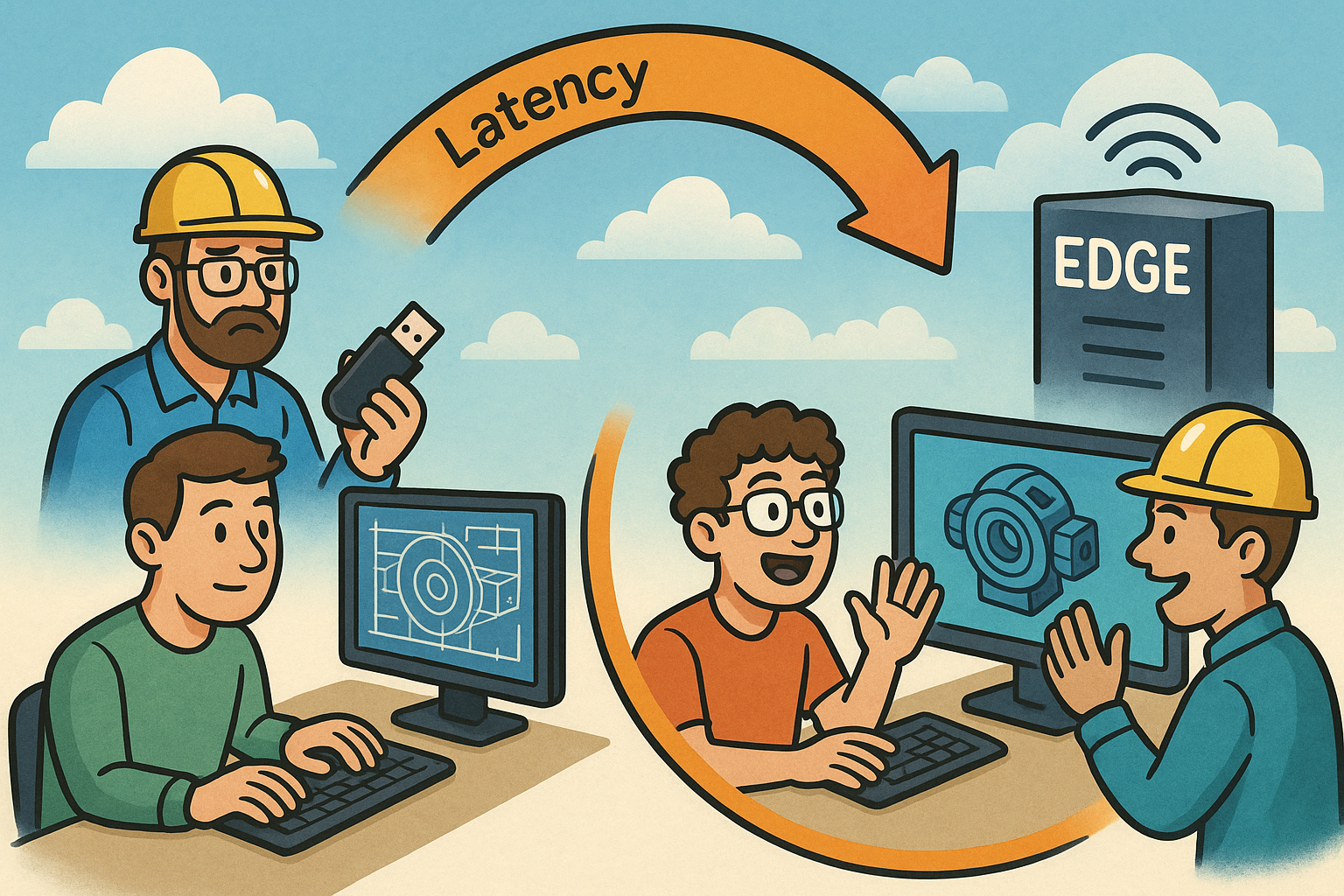Your Cart is Empty
Customer Testimonials
-
"Great customer service. The folks at Novedge were super helpful in navigating a somewhat complicated order including software upgrades and serial numbers in various stages of inactivity. They were friendly and helpful throughout the process.."
Ruben Ruckmark
"Quick & very helpful. We have been using Novedge for years and are very happy with their quick service when we need to make a purchase and excellent support resolving any issues."
Will Woodson
"Scott is the best. He reminds me about subscriptions dates, guides me in the correct direction for updates. He always responds promptly to me. He is literally the reason I continue to work with Novedge and will do so in the future."
Edward Mchugh
"Calvin Lok is “the man”. After my purchase of Sketchup 2021, he called me and provided step-by-step instructions to ease me through difficulties I was having with the setup of my new software."
Mike Borzage
Harnessing the Power of Digital Twins: Revolutionizing Engineering Design and Innovation
October 06, 2024 10 min read


Definition and Concept
In the realm of modern engineering design, the concept of the digital twin has emerged as a transformative force driving innovation and efficiency. A digital twin is a virtual representation of a physical object, system, or process that spans its lifecycle, is updated from real-time data, and uses simulation, machine learning, and reasoning to help decision-making. This digital replica enables engineers and designers to understand not only how products are performing but also how they will perform in the future. The significance of digital twins in engineering design lies in their ability to bridge the gap between the physical and digital worlds, providing a comprehensive platform for analysis, optimization, and innovation.
By creating a digital counterpart to a physical asset, engineers can simulate scenarios, predict outcomes, and identify potential issues before they manifest in the real world. This proactive approach reduces risks, saves costs, and accelerates the design process. The digital twin encompasses data from sensors, historical records, and other sources to provide a holistic view of the asset's performance. This integration of data and simulation tools allows for continuous improvement and adaptation, which is crucial in today's fast-paced engineering environments. The digital twin concept extends beyond mere modeling; it is an evolving digital profile that reflects changes and updates, ensuring that the virtual representation remains an accurate mirror of the physical counterpart.
The adoption of digital twins signifies a paradigm shift in engineering design, moving towards a more interconnected and intelligent approach. It empowers stakeholders to make informed decisions, enhances collaboration among teams, and fosters innovation through advanced analytics and predictive insights. As industries become more complex and data-driven, the utilization of digital twins becomes indispensable for maintaining competitiveness and achieving operational excellence. The digital twin serves as a foundational element in the digital transformation journey, enabling organizations to harness the full potential of their assets and processes.
Historical Context
The evolution of digital twin technology can be traced back to the early days of simulation and modeling in engineering. Initially, physical prototypes and models were the primary means for testing and validation. These methods were time-consuming, costly, and limited in their ability to represent complex systems accurately. With the advent of computer-aided design (CAD) and computational modeling in the late 20th century, engineers began to leverage digital tools to create detailed models and simulations. However, these models were often static and lacked real-time data integration.
The concept of the digital twin as we understand it today was first articulated by Dr. Michael Grieves at the University of Michigan in 2002. He proposed the idea of a virtual, digital equivalent to a physical product, which could be used throughout its lifecycle for various purposes such as design, testing, and maintenance. This marked the beginning of a shift from static models to dynamic, data-driven digital representations. The rise of the Internet of Things (IoT) and advancements in sensor technology further propelled the development of digital twins by enabling continuous data flow between physical assets and their digital counterparts.
Over the past two decades, digital twin technology has evolved from a theoretical concept to a practical tool widely adopted across industries. The integration of high-speed data analytics, machine learning, and cloud computing has enhanced the capabilities of digital twins, making them more accessible and effective. The transformation from physical models to digital representations signifies a significant milestone in engineering design, allowing for more sophisticated analyses, real-time monitoring, and predictive maintenance. This historical progression highlights the continuous pursuit of efficiency and innovation in engineering practices.
Real-Time Monitoring and Simulation
One of the most impactful applications of digital twins in engineering design is real-time monitoring and simulation. By leveraging the continuous data collection from physical assets, digital twins provide an up-to-date virtual model that reflects the current state of the system. Engineers can monitor performance metrics, detect anomalies, and simulate various scenarios to predict future behavior. This real-time insight enables proactive decision-making and swift responses to potential issues, thus enhancing operational efficiency and reducing downtime.
The integration of sensors and IoT devices facilitates the constant flow of data to the digital twin. This data includes parameters such as temperature, pressure, vibration, and other critical indicators pertinent to the asset's performance. The digital twin processes this information to simulate the asset's behavior under different conditions. Engineers can adjust variables within the digital twin to observe potential outcomes without interfering with the actual physical asset. This capability is invaluable for optimizing performance, testing new configurations, and implementing innovative solutions safely.
Real-time simulation through digital twins empowers organizations to stay ahead in competitive markets by enabling rapid iteration and continuous improvement. It reduces the reliance on physical prototypes and extensive testing phases, thereby saving time and resources. Additionally, the insights gained from simulations can lead to enhancements in product design, increased reliability, and better customer satisfaction. By harnessing the power of real-time data and simulation, digital twins revolutionize the way engineers approach design and problem-solving.
Predictive Maintenance
Another significant application of digital twins in engineering design is in the realm of predictive maintenance. Traditional maintenance strategies often rely on scheduled intervals or reactive responses to failures, which can lead to unnecessary downtime and increased operational costs. Digital twins enable a more sophisticated approach by providing a detailed understanding of wear and tear on assets through continuous monitoring and data analysis. This allows engineers to predict when maintenance is required, based on the actual condition of the equipment rather than predetermined schedules.
By analyzing patterns and trends in the data collected, digital twins can identify indicators of potential failures before they occur. This predictive capability helps in scheduling maintenance activities at optimal times, reducing unexpected breakdowns and extending the lifespan of assets. The benefits of predictive analysis include minimized downtime, enhanced safety, and cost savings. Organizations can allocate resources more efficiently and ensure that critical systems remain operational when needed most.
Implementing predictive maintenance through digital twins involves integrating various data sources and utilizing advanced analytics. Machine learning algorithms can be applied to historical and real-time data to improve the accuracy of predictions. Additionally, engineers can simulate different maintenance scenarios within the digital twin to determine the most effective strategies. This proactive approach transforms maintenance from a reactive necessity into a strategic advantage, contributing to overall operational excellence.
Design Validation and Testing
The use of digital twins for design validation and testing represents a significant advancement in engineering design processes. Virtual testing before the creation of physical prototypes allows engineers to explore a wide range of design options, identify potential issues, and optimize performance without the costs and time associated with physical testing. The digital twin serves as a dynamic environment where variables can be adjusted, and the impacts can be analyzed in detail.
This approach accelerates the development cycle by enabling rapid iteration and refinement of designs. Potential flaws or inefficiencies can be detected early in the process, reducing the risk of costly redesigns later on. Engineers can assess how different materials, components, or configurations affect the overall system performance. The ability to conduct extensive testing in a virtual setting ensures that the final design is robust, efficient, and meets all necessary specifications and standards.
Moreover, design validation through digital twins fosters innovation by allowing engineers to experiment with unconventional ideas without the limitations imposed by physical prototypes. This flexibility encourages creative solutions and can lead to breakthroughs that might not have been feasible otherwise. By streamlining the validation and testing phase, digital twins contribute to faster time-to-market and enhanced competitiveness in the engineering sector.
IoT and Sensor Technologies
The role of IoT devices in creating accurate digital twin models is pivotal. IoT and sensor technologies provide the necessary data inputs that keep digital twins updated and reflective of real-world conditions. Sensors embedded in physical assets collect a vast array of data, including environmental factors, operational parameters, and performance metrics. This continuous data stream is essential for maintaining the accuracy and reliability of the digital twin.
Various types of sensors are used across different engineering sectors. For instance, in manufacturing, sensors might monitor machinery temperature, vibration, or load, while in the aerospace industry, they could track stress factors on aircraft components. In civil engineering, sensors might measure structural integrity or environmental conditions affecting infrastructure. The integration of these sensors enables the digital twin to provide a comprehensive and nuanced portrayal of the physical asset.
- Temperature Sensors: Monitor heat levels to prevent overheating and ensure optimal operating conditions.
- Pressure Sensors: Track pressure within systems to identify leaks or inefficiencies.
- Vibration Sensors: Detect unusual vibrations that could indicate mechanical failures.
- Environmental Sensors: Measure humidity, air quality, and other environmental factors impacting asset performance.
The synergy between IoT devices and digital twins enhances predictive capabilities and allows for real-time adjustments. This interconnected ecosystem supports smarter decision-making and more responsive engineering practices. As IoT technology continues to advance, the potential for even more detailed and sophisticated digital twins grows, further solidifying their role in modern engineering design.
Artificial Intelligence and Machine Learning
The integration of artificial intelligence (AI) and machine learning significantly enhances the functionality of digital twins. AI algorithms can process and analyze the large volumes of data generated by sensors and IoT devices, extracting valuable insights that might be overlooked by human analysis. Machine learning enables digital twins to learn from historical and real-time data, improving predictive accuracy and decision-making over time.
Use cases of machine learning in digital twins include anomaly detection, predictive maintenance, and optimization of operational efficiency. For example, machine learning models can identify patterns associated with equipment failures, allowing engineers to anticipate and prevent issues before they occur. AI can also optimize system performance by adjusting parameters in real-time based on the analysis of data trends and predictive models.
The incorporation of AI and machine learning transforms digital twins from static models into intelligent systems capable of autonomous decision-making. This level of sophistication supports more complex simulations and provides deeper insights into system behaviors. Engineers can leverage these technologies to enhance design processes, improve product quality, and drive innovation. The combination of AI, machine learning, and digital twins represents a powerful toolset for addressing the challenges of modern engineering.
BIM (Building Information Modeling) and Digital Twins
The synergy between BIM and digital twin technologies is particularly evident in the fields of architecture, construction, and urban planning. Building Information Modeling (BIM) is a process involving the generation and management of digital representations of physical and functional characteristics of places. When combined with digital twins, BIM models become dynamic, data-rich representations that extend beyond design and construction into the operational lifecycle of a building or infrastructure.
In architecture and construction, digital twins enable stakeholders to visualize and simulate the performance of buildings before they are constructed. This includes energy consumption, structural integrity, and occupant comfort. Urban planners can use digital twins to model entire cities, optimizing traffic flow, resource allocation, and emergency response strategies. The integration of real-time data from IoT devices allows these models to adjust to changing conditions and support informed decision-making.
- Design Optimization: Digital twins help in refining architectural designs to meet sustainability and efficiency goals.
- Construction Management: Virtual simulations assist in planning construction sequences and identifying potential issues.
- Facility Operations: Real-time monitoring of building systems enhances maintenance and reduces operational costs.
- Urban Planning: Modeling city infrastructure supports smart city initiatives and improves quality of life.
The collaboration between BIM and digital twin technologies enhances communication among architects, engineers, contractors, and clients. It ensures that all parties have access to accurate, up-to-date information, facilitating better coordination and reducing the likelihood of errors. This integrated approach streamlines the entire lifecycle of projects from conception to decommissioning, promoting sustainability and efficiency in the built environment.
Data Management and Security Concerns
As digital twins become more prevalent, issues related to data privacy and integrity emerge as significant challenges. The vast amounts of data collected and processed by digital twins include sensitive information that, if compromised, could have serious implications for organizations and individuals. Data security is paramount to protect intellectual property, maintain competitive advantage, and comply with regulatory requirements.
Potential threats include cyberattacks, unauthorized access, and data breaches that could disrupt operations or expose confidential information. To address these concerns, organizations must implement robust security measures such as encryption, access controls, and network security protocols. Regular security assessments and audits are essential to identify vulnerabilities and ensure compliance with industry standards.
Solutions for protecting sensitive engineering data involve a combination of technology, policies, and employee training. Implementing secure cloud services, using blockchain technology for data integrity, and enforcing strict data governance policies help safeguard information. Educating employees about security best practices and fostering a culture of vigilance is also crucial. By prioritizing data management and security, organizations can confidently leverage digital twin technology without exposing themselves to undue risks.
Scalability and Implementation
When it comes to adopting digital twin technology, organizations often face challenges related to scalability and implementation. Integrating digital twins into existing workflows requires careful planning, investment, and change management. Technical hurdles may include compatibility with legacy systems, data integration complexities, and the need for specialized skills and expertise.
Scaling digital twin technology across an organization involves ensuring that systems can handle increased data volumes, processing demands, and user access without degradation of performance. This requires robust IT infrastructure, scalable software solutions, and efficient data management practices. Additionally, aligning different departments and processes to support a unified digital twin strategy can be challenging.
Strategies for seamless integration include adopting modular and flexible digital twin solutions that can be tailored to specific needs. Collaborating with technology partners and consultants can provide the necessary expertise and resources. Incremental implementation, starting with pilot projects and gradually expanding, allows organizations to manage risks and adjust approaches based on feedback and results. Effective communication and training are essential to gain buy-in from stakeholders and ensure that teams are equipped to utilize digital twins effectively.
Looking Ahead
The future developments in digital twin technology promise to further revolutionize engineering design processes and innovation trends. Advancements in areas such as artificial intelligence, quantum computing, and immersive technologies like virtual and augmented reality will enhance the capabilities of digital twins. These enhancements will enable even more detailed simulations, real-time collaboration across the globe, and more intuitive interactions with digital models.
Potential impacts on engineering design include the ability to model highly complex systems with unprecedented accuracy, leading to breakthroughs in fields like aerospace, biotechnology, and renewable energy. Digital twins could become standard tools in education and training, providing hands-on experience without physical resources. The integration of digital twins with global data networks could facilitate large-scale projects addressing climate change, infrastructure development, and sustainable resource management.
As digital twin technology continues to evolve, its adoption will likely expand across industries and sectors. Organizations that embrace these advancements will be better positioned to innovate, respond to market demands, and contribute to solving some of the world's most pressing challenges. The journey ahead is filled with opportunities for those willing to explore and invest in the potential of digital twins.
Also in Design News

Live Performance Budgets: Real-Time Cost, Carbon, Energy and Lead-Time in CAD/BIM
December 11, 2025 14 min read
Read More
Design Software History: From File-Shuttling to Edge: The Latency Evolution of Collaborative CAD and Real-Time Visualization
December 11, 2025 13 min read
Read More
Cinema 4D Tip: Cinema 4D Soft Body Quick Setup & Parameter Tuning
December 11, 2025 2 min read
Read MoreSubscribe
Sign up to get the latest on sales, new releases and more …


